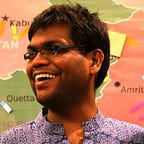A Pilgrim’s Limited Progress
(This book review was first published in Business Standard.)
The core meaning of pilgrimage, for me, is going on a physical journey to catalyze an inward exploration. The intention matters as much as the travel itself, if not more. What is needed on the way is a readiness to discover new maps of longing and desire, old pathways to resilience and wisdom, and fellow travellers who come and go.
The COVID-19 pandemic brings us an opportunity to dive into what pilgrimage involves apart from deciding on a place, creating an itinerary, booking tickets, and sorting out the accommodation. How does it expand our notions of time and space? What does it teach us about our cultural inheritance? How can we continue to be pilgrims in a state of lockdown?
Mull over these questions as you read Devdutt Pattanaik’s new book Pilgrim Nation: The Making of Bharatvarsh published by Aleph Book Company. It is woven around the author’s personal connection with 32 pilgrim sites, many of which have also become tourist spots. He is not interested in telling you how to get there, where to stay, and what to eat. He gives you an intimate narrative of what each place means to him as a devotee and mythologist.
Pattanaik writes, “To me, temples are centres of installation and performance art. Through these art forms, which include music, food, fashion, painting, poetry, dancing, every sense is aroused to experience the divine. Every temple has its own flavour. The experience of Krishna as Vitthala of Pandharpur, presented through the lyrical march of the Varkaris, is very different from the Krishna experienced amidst the colourful chariots of Jagannath of Puri, Odisha.”
Is this book only about Hindu shrines in India? No, the conceptual landscape of Bharatvarsh is informed by ideas of mythological time, sacred geography and political ideology. It cannot be mapped on to post-1947 India or contemporary South Asia in any simplistic way. Read the book to know more. It covers Hindu, Buddhist, Jain, Sikh, Parsi, Christian and Islamic pilgrimage sites.
Since a pilgrimage is always about diving within, this book also turns its gaze towards the author’s relationship with faith. A wonderful example of this is the chapter dedicated to Saundatti, the famous Renuka Temple on the border of Maharashtra and Karnataka. He was on his way to Dharwad from Belgaum Airport when he asked his host, ‘Isn’t Saundatti nearby?’ Guess what happened after that.
Pattanaik writes, “The question came out of the blue. One thing led to another and, before we knew it, we were taking a detour from the highway, and making our way to the pilgrim site.” Going to that temple was not a part of his original plan but he was willing to accommodate it by acknowledging the concept of ‘bulava’ or ‘calling’, “when people feel an inexplicable urge and are drawn to a particular pilgrim site.”
This conversational tone is what makes Pattanaik’s book a joy to read. He believes that you get to see a deity only when the deity wants to see you. Many pilgrims returning from unsuccessful trips console themselves with the thought that their time was not right. It is clear that he has written it for fellow pilgrims; not for people who consider religion to be the opium of the masses, and spirituality to be an indulgence for the bourgeoisie.
In a charming account of his pilgrimage to Ranakpur, which is sacred to Jains, the author writes with emotion about an image on a ceiling. It is an exquisitely carved marble leaf of the Kalpa Vriksha, the mythical wish-fulfilling tree. If you stand under it, and make a wish, it will be granted. When the tourist guide offered this information, Pattanaik quickly joined a queue of eager pilgrims. He too wanted to make a wish.
While he made this wish, he overheard a woman say, “They don’t seem to get the irony. Above is the leaf that fulfills all your desires. And before them is the sage, once king of all the world, who has given up all he possessed, for he has outgrown all desires.” This kind of banter is commonplace at pilgrimage sites, where devotion and philosophy coexist with commerce and chaos.
What does not work in this book is Pattanaik’s characterization of Hinduism as a beacon of inclusion and tolerance. He seems reluctant to address the fact that a large number of temples restrict entry to people of the so-called lower castes because of rigid norms around purity and pollution. The ecstasy of darshan is not available to all. He also glosses over the critique of caste offered by the bhakti movement.
Pattanaik romanticizes the lives of devadasis, paying little heed to the sexual violence they experienced at the hands of Brahmin men. He writes, “Bejewelled women once lived in Hindu temples immersed in art, dancing, singing, and making music. They had multiple lovers, for they were bound to the deity and not to any one man. Their beauty was captured for posterity in the sensuous images on temple walls.”
His view of the interface between Hinduism and Islam is also anchored in repeatedly casting Muslims as outsiders, idol breakers and those who ruled by the power of the sword. It is important to document destruction of Hindu heritage by Muslim rulers, and equally vital to recognize that people who were subject to discrimination within the caste system may have embraced Islam hoping to find dignity.
The householder versus hermit framework that he uses to compare Hinduism with Jainism and Buddhism is of limited value. It erases the experiences of women who are devotees, seekers and pilgrims. By reducing Jainism and Buddhism to the monastic communities of both religions, Pattanaik loses out on understanding the vibrant role played by lay practitioners in maintaining their pilgrimage sites. He also conveniently ignores how Brahminical Hinduism has appropriated local village deities, Jain pilgrim sites as well as the Buddha.
